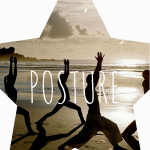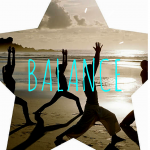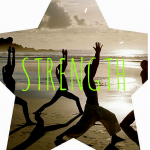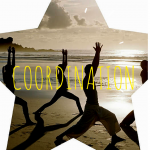Exercise Ball (aka Balance Ball, Stability Ball, Swiss Ball)
There are several benefits for using an exercise ball as a chair for sitting exercises for the elderly. Below is a video explaining the reasons and demonstrating how I use the exercise ball in the home to do sitting exercises! You just can’t beat the benefits of an exercise ball as a chair for sitting exercises and other uses! I encourage you to watch the video and continue to read.
For additional information about Exercise Ball Benefits, Please continue to read.
Benefits
 Improved posture
Improved posture
Unlike sitting on a chair or any other flat surface, the ball’s shape encourages proper sitting posture and body alignment (shoulders above the hips). If the shoulders are shifted any direction, the redistribution of weight challenges overall balance, and the ball shifts in response to the altered postural alignment. Consequently, the abdominal, back and leg muscles engage and AUTOMATICALLY respond to correct the alignment, control the loss of balance, and restore sitting stability.
Sitting exercises on a flat surface (chair, bed, gym/rehab table) do NOT challenge posture to improve postural control (keeping the shoulders over the hips when the legs are moving).
QUESTION: Is it possible to slump/slouch down sitting on a chair/bed and still be able to raise a knee up?
ANSWER: Yes, it is possible. In fact, I challenge you to sit down and slump over (round the shoulders forward over your legs and then raise one knee up and down. Now sit with your hips toward the edge of the chair with your shoulders behind you (BE CAREFUL not to sit too close to the edge of the chair because you can slip out of the chair when you move your shoulders backward) and do a knee raise.
Sitting on a flat, firm surface does not challenge or improve posture. So why worry about poor posture in your loved one? If sitting posture is bad, standing posture will be worse and walking is both more DIFFICULT and DANGEROUS. Furthermore, breathing is more difficult.
TRY THIS: round your shoulders forward again (slump over in sitting or standing) and now try and take a deep breath! Now, sit or stand up with your shoulders over your hips and take a deep breath. Subsequently, if you add any breathing problems your loved one might already have (asthma, COPD, Emphysema, Pneumonia) to poor posture–no wonder he/she is short of breath, easily fatigued, and weak with very light activities.
 Improved Balance
Improved Balance
Being able to move either in sitting or standing without staggering, stumbling, or falling takes good balance, reaction time, and coordination. Balance is time-sensitive. In other words, slow reaction times combined with weak muscles or poor balance strategies will increase your loved one’s fall risk. If you want to improve balance, you have to challenge your balance.
For example, when learning to ride a bike, you have to learn how to BALANCE on two wheels that are in alignment. At first, you lose your balance side-to-side, start out really slow, and have to put your foot down quickly to prevent falling. Eventually, you learn how to balance and ride in a straight line but turning is more difficult and requires a slightly different balance strategy. If you persevere, you can successfully keep your balance while turning both directions. Later, you challenge your balance more by increasing the speed, jumping ramps/inclines, or even riding WITHOUT any hands! In summary, first you lose your balance, then you challenge/strengthen your balance strategies, and eventually you can do more without falling.
Now let’s compare balance sitting on a flat surface (bed, chair) to sitting on an exercise ball.
QUESTION: What is providing the balance/stability in each situation?
ANSWER: The flat surface is providing all the balance/stability when you exercise on a chair or bed. Your legs, abdominal muscles, and core are providing the balance/stability because the ball DOES NOT and WILL NOT balance you. TRY or THINK ABOUT THIS: Can you sit on a chair with one foot off the ground and still be able to kick the other foot out in front of you or raise the other knee up and down? Now, can you sit on a ball with one foot completely off the ground and still move the other leg (kick or march the knee up and down)? You can move your leg when the other is completely off the ground while sitting on a chair/bed because the CHAIR/BED is supplying all the balance you need. However, when sitting on a ball, your BODY must react with the ground for you to keep your balance because the BALL does not provide ANY external balance.
 Improved Strength
Improved Strength
WARNING: THE FOLLOWING STATEMENTS ARE MY OPINIONS BASED ON MY EXPERIENCES!!!
If my patients demonstrated improved functional independence during standing, walking, transferring, and bed mobility doing sitting exercises on a chair/bed with therabands, ankle weights, or a floor bike, then I would have them do these tasks until the cows come home. HOWEVER, I have not observed any significant or pronounced functional outcome with standing, walking or transferring doing these TYPICAL exercises on a chair/bed; therefore, I DO NOT use these techniques while treating my patients. If my patients do ANY sitting exercises, they do them while sitting on an exercise ball!
What is one of the requirements for building strength? Resistance! Our bodies respond to the forces we put on them. When someone goes to the gym with the purpose of their workout focused on improving his/her overall strength, they utilize resistance either with weights, exercise equipment, or moving their own body weight against gravity to build muscle strength. Furthermore, combining muscle groups and movements is more effective than isolating specific muscles when building strength.
Sitting on a ball allows a wide variety of movements and when someone is extremely weak–like my patients that are technically/literally unable to physically leave their home due to their pronounced weakness/fatigue–moving their own body weight against the force of gravity to stand up, transfer, get in/out of bed, sit without back support or walk short distances is extraordinarily difficult. Therefore, in the home setting, I focus my strengthening exercises around my patient being successful, efficient and safe moving their body weight against gravity and combining different movements simultaneously.
For example, on the exercise ball, I have my patients bounce up and down while simultaneously shifting their weight all directions in a circular pattern, OR I have them complete sit to stand transfers combined with different foot positions and/or using one hand to no hands while standing up. The resistance created from my patient’s body weight reacting to the shift and dynamic movements of the ball simultaneously improve the FUNCTIONAL strength of various muscle, the balance strategies of the hip/ankles, the postural alignment and control of the core, and general coordination between numerous joints and muscle groups.
When compared to sitting on a flat, firm, static (immobile) surface such as a chair or bed, leg strength generally does not improve–especially in the muscles required for maintaining balance, postural alignment, coordination and endurance for standing up, walking, transferring, and bed mobility.
 Improved Coordination
Improved Coordination
Robots move in one or maybe 2 dimensions. Physical therapists battle choppy, robotic movements especially when patients are turning in a circle while standing up, walking with a cane or walker, and transitioning from side lying to sitting or sitting to standing. Every movement we make requires a symphony of coordinated movements, muscles, joints and systems (nerves, heart, lungs, senses, etc…). Sitting and exercising on an exercise ball improves coordination through multidimensional movements (up, down, side-to-side, forward and backward). It is easier to have robotic, isolated movements while exercising and sitting down on a chair/bed. Doing the exact same exercises on a ball (sitting on air) will produce smoother, more controlled and coordinated movements due to the shape/surface of the ball and how your body reacts to the movements of the ball.
 Decreased Effort/Reps without Sacrificing Results
Decreased Effort/Reps without Sacrificing Results
Typically, patients get frustrated and bored with repeating more than 10 repetitions of the same exercise over a short period of time. Everyone likes knowing they are working SMARTER and not HARDER! I can have my patients complete decreased repetitions of different exercises (movement patterns) on the exercise ball because every movement on the ball incorporates posture, balance, muscle strength, and coordination. In other words, one leg cannot be on vacation while the other leg is moving, core strength is engaged, proper postural alignment is active/reactive, breathing and balance are improved, and overall coordination is challenged. Unlike exercising on a chair/bed, the ball is similar to in-home circuit or interval training so doing fewer reps/exercises yields greater results.
Here are products and links to purchase your own exercise ball!
RELATED PRODUCTS
Below I have listed the 5 exercises I use with most of my patients to warm them up before I customize the rest of their treatment to meet his/her specific needs and goals. Please, leave me a comment or ask me a question if you are interested in learning more about home-based exercises on an exercise ball for knee replacements, hip replacements, and other diagnoses.
General Exercises Appropriate for Several Disorders & Deficits
Bouncing
Weight Shifts all directions (rocking forward/backward & Side-to-Side shifts, circles clockwise/counter-clockwise)
Knee Raises (Marches)
Kicks
Sit-to-Stand from the ball
Other Uses for an Exercise Ball
Swelling Control – I place the ball under the ankles to elevate the feet above the level of the heart for swelling control. I can place the ball on the footrest of a recliner, on the bed, or even on the couch for effective swelling management.
Pressure Relief – If my patients have a pressure sore (decubitus ulcer) on the heel, I can relieve the pressure and manage any swelling due to the curve of the ball.
Alternative Sitting – The ball is an excellent chair! My daughters use an exercise ball at their computer desks. The ball promotes posture, improved level of alertness, and helps my daughters get through their homework with decreased mental fatigue after school. My daughters stay awake even after a long day at school through bouncing! Their posture, like my patients, is improved and they stay focused until their homework is complete. I have recently read blogs where office personnel use balance balls at their desks and have noticed decreased back pain with improved posture and productivity! An exercise ball is inexpensive and very versatile not only in the home but in the office as well.
WARNING: If there are children present in the home, the ball will most likely be confiscated for their fun and entertainment–this is a common occurrence when I am treating a patient, using the ball, and children are in the home.
If you have an exercise ball or want to share your story, I would love to hear from you! If you have any questions, please leave me a comment below and I will get back to you withing 48 hours.
I hope you enjoyed and learned something new, and I look forward to hearing from you!
Best Regards,
Leave a Reply